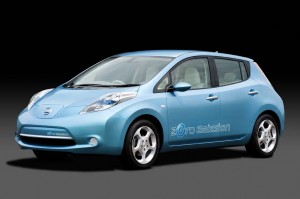
The 2011 Nissan Leaf is making its public debut in Tokyo this week, where CEO Carlos Ghosn announced plans for an Infiniti battery car.
Nissan Motor Co. is going big for electric power, the automaker confirmed during its Tokyo Motor Show news conference today.
The automaker’s CEO Carlos Ghosn revealed Nissan’s luxury division, Infiniti, will add a compact four-door battery car to its line-up. It will join a fast-expanding array of Nissan electric vehicles.
While Ghosn declined to provide details, he noted that the Infiniti model will comply with the brand’s motto of “inspired performance.”
Ghosn drove onto the stage, at Makuhari Messe, in a tandem two-seat battery car, dubbed the Land Glider. But it appears unlikely the unusual, narrow-gauge model will be among the new zero-emission alternatives to reach production.
Earlier this year, Ghosn revealed that the flagship Nissan brand will introduce its first battery-electric vehicle, or BEV, in 2011. And a battery version of the NV200 commercial van is under development, as well, the Brazilian-born executive, who also serves as CEO of Nissan’s Alliance partner, Renault, revealed in Tokyo.
Yet another BEV is expected to join the Nissan brand line-up, company sources are indicating.
Nissan was late to the hybrid party and Ghosn has repeatedly expressed skepticism about the technology, preferring to put the automaker’s emphasis on pure electric propulsion.
Leaf, which was unveiled during the dedication of Nissan’s new Yokohama headquarters, is expected to initially deliver a bit more than 100 miles range. But company sources have told TheDetroitBureau.com that they hope to more than double that within a few years. When it debuts, in 2011, Leaf will be targeted at fleet customers who can give the battery car a more controlled real-world test. But a year later, it will go on sale to the general public.
To overcome concerns about high cost and low mileage, Infiniti is working with a variety of partners, including Project Better Place, which is setting up a series of quick-swap battery centers, in Israel and several other markets. Rather than waiting for an extended charge, owners would simply have their discharged batteries switched for new ones.
Meanwhile, Nissan may take the approach of selling battery cars to retail customers but leasing them the battery for approximately the same amount as they’d normally expect to pay for gasoline every month.
Even the method of charging a battery car could change, at least if the Land Glider concept is any indication of what the Japanese carmaker has in mind. Instead of connecting the 2-seater to a wall plug or special charger, a motorist would simply pull up to a special induction station which would allow the vehicle to recharge wirelessly.
While Ghosn suggested Land Glider could reach production, observers think the quirky design has little real future. But if it did, it would likely be limited to Japan and other crowded markets where demand for pint-sized urban runabouts is expected to grow in the coming decades.
